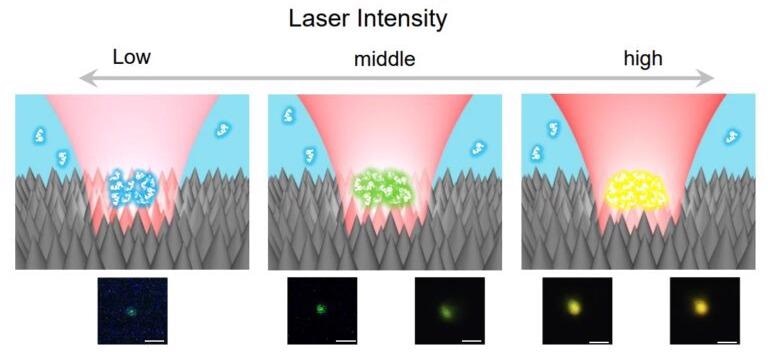A new trapping technique was created by Osaka Metropolitan University using “optical tweezers” altered with nanotextured black silicon and a polymer solution modified with perylene. The technique establishes a completely reversible remote control of color.

Image Credit: Osaka Metropolitan University.
Color control is one huge stumbling block in the photonics field. To date, researchers needed to alter the concentration of the solvent or chemical structure of the emitter — all of which need direct contact, considerably restricting their application — to control color, which is the wavelength of light emission.
Such conditions make it impossible to change color quickly, use it as a light source in microscopic spaces like a cell, or in closed systems where exchange is not an option.
Yasuyuki Tsuboi, Professor, Department of Chemistry, Osaka Metropolitan University
Prof. Tsuboi headed a group of researchers to demonstrate that it is feasible to control the luminescence color remotely, with only the light pressure effect, using “optical tweezers” — a technology he developed in previous research.
Their results were recently published online in the German international journal Angewandte Chemie International.
For many years, Prof. Tsuboi and his co-workers have been performing research on a technology that can catch and influence micrometer- and nanometer-sized materials with a laser.
While studying this “optical tweezer” technology, the team discovered that when a silicon crystal with a distinct needle-shaped nanostructure, known as black silicon, was immersed in a sample solution, the optical field enhancement effect of the nanostructure captured a perylene-modified polymer — leading to a local concentration of the solution to enhance and create an aggregate of polymers.
“When the concentration of the perylene increases, it forms a dimeric excited complex called an excimer,” describes lead author Ryota Takao. Depending on the degree of concentration, these excimers emit fluorescence that can change color.
This is what the scientists examined in the earlier trapping experiments without employing a trapping laser.
In this study, they discovered that as the intensity of the laser beam increased, light pressure also increased — causing the polymer aggregate concentration on the black silicon to get denser and vice versa.
We observed the color of the fluorescence emitted by the polymer aggregate change in response to this. With low intensities producing blue, and then changing to green, yellow, green-yellow, to orange as the intensity increases.
Yasuyuki Tsuboi, Professor, Department of Chemistry, Osaka Metropolitan University
The color change is completely reversible and can be done remotely since the laser intensity is what is being controlled here.
As the research is still in its starting stage, it depends on the excited complexes and transfer of excitation energy, which implies possible applications in near-infrared and ultraviolet regions, together with the visible realm.
At present, the team is promoting more research in the direction of encapsulating the perylene-modified polymer solution to be utilized as a source of light in micromachine elements and intracellular bioimaging.
Journal Reference:
Takao, R., et al., (2022) Fluorescence Colour Control in Perylene-Labeled Polymer Chains Trapped by Nanotextured Silicon. Angewandte Chemie International. doi.org/10.1002/anie.202117227.